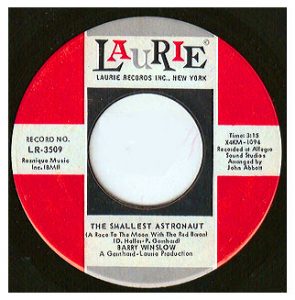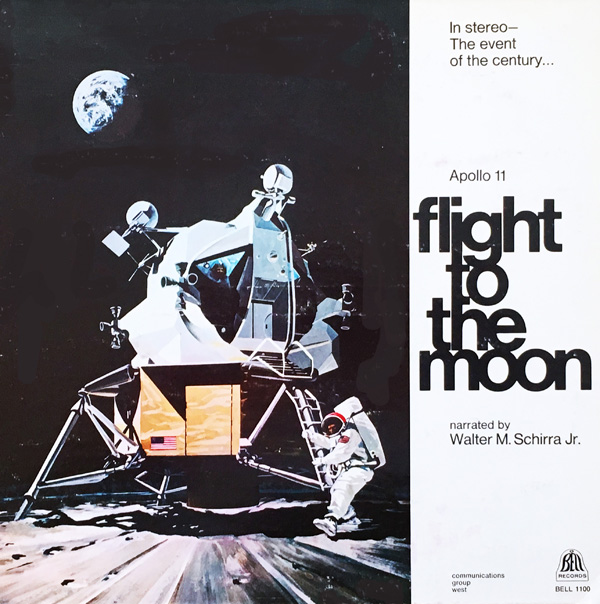Charlie Brown and Snoopy were so part of the national zeitgeist, they were included in the Apollo project, and the fact and whimsy was captured on two very different 1969 records.

THE SMALLEST ASTRONAUT
(A Race to the Moon with the Red Baron)
Barry Winslow
Laurie Records LR-3509 (7” 45 RPM / Mono)
Side B: “Quality Woman”
Released in 1969. Producer: Phil Gernhard. Songwriters: Phil Gernhard, Dick Holler. Arranger: John Abbott. Recorded at Allegro Studios, Running Time: 3 minutes.
 Reportedly, the astronauts of Apollo 10—the mission just before the one that landed on the moon—came up with the idea to name their Command Module “Charlie Brown” and their Lunar Module “Snoopy.” It’s an honor no other comic or cartoon characters can truly equal.
Reportedly, the astronauts of Apollo 10—the mission just before the one that landed on the moon—came up with the idea to name their Command Module “Charlie Brown” and their Lunar Module “Snoopy.” It’s an honor no other comic or cartoon characters can truly equal.
Snoopy was a natural for space exploration of course, since he had been fantasizing about flight for years. The Royal Guardsmen found great success in turning his battles with the Red Baron into novelty records, beginning with 1966’s “Snoopy vs. the Red Baron,” which we talked about at length in this Spin.
There were several follow-ups to “Snoopy vs. the Red Baron,” the most popular being “Snoopy’s Christmas.” But a lesser known disc appeared in 1969 around the time of Apollo 10. “The Smallest Astronaut” does not mention Snoopy. The Royal Guardsmen are also not listed, just the lead singer/guitarist Barry Winslow. Whether or not that implies an attempt at a solo career for Winslow and a lack of copyright for Snoopy, the song was reissued nine years later on the other side of a reissue of “Snoopy’s Christmas.” Although not originally an album track, it turned up on a few compilations.

Fifty years since the moon landing—now that “hey, let’s name these space things after Snoopy and Charlie Brown” has become “hey, let’s leverage this event into a multi-platform I. P. initiative”—appleTV has purchased the Peanuts library. This fall they salute the Peanuts moon legacy with a special called Snoopy in Space.
Charlie Brown’s traditions being what they are—not keeping a kite in the air, never kicking a football—his Apollo 10 mission did not result in a landing on the moon. “Snoopy” got about eight miles from the surface and they both orbited over thirty times. However, that mission made Apollo 11 possible, though it seldom gets the credit it deserves. You’re a good mission, Apollo 10!

APOLLO 11: FLIGHT TO THE MOON
Narrated by Walter M. Schirra, Jr.
Bell Records (Columbia Pictures) BELL-1100 (12” 33 1/3 RPM LP / Stereo)
Released in 1969. Created and Produced by Communications Group West, Hollywood. Producers: Sidney Galanty, Lanny Sher. Writer: Norman Corwin. Music: Earl Robinson. Engineer: Art Becker. Design: Thayne Madrid, Rick Strand. Running Time: 38 minutes.
Wally Schirra was a familiar 1960’s and 70s TV presence sitting next to Walter Cronkite during the CBS News coverage of moon landings. He was the only astronaut to have flown on the Mercury, Gemini and Apollo programs. And while there were quite a few fine recordings made about the space program, for adults and kids, having actual astronaut narration adds a “cool factor” of authenticity. He’s no Paul Frees, but even Frees would probably rather hear Schirra in this case.
As for the script, anyone who knows classic radio knows Norman Corwin. If this two-time Peabody award winner were best known for stage, TV or movies, even more of the world would hail him as one of the great minds of the 20th century. He created an endless flow of great radio drama, but what are most famous are his narratives—dramatic oratorios with full casts and music that evoke moments in history, great people, ordinary people, and even just life itself. He painted portraits in sound with full casts (often star-studded ones), musical scores, songs and poems. People like Gene Roddenberry and Rod Serling considered him an inspiration. This is the Oscar-winning 2006 documentary about his life and work:
Corwin’s longtime musical associate, Earl Robinson, wrote the score for this album. Robinson wrote a number of groundbreaking social commentaries in song, including one for the Oscar-winning short, “The House I Live In,” with Frank Sinatra, and “Ballad for Americans,” which was a signature song for Paul Robeson. No small amount of thought went into how this Apollo recording was going to be produced, and who was going to create it.
The stereophonic sound is nicely used, to keep the music spread evenly around the narration and historic clips, to sometimes move them from one channel to another, to distribute the sound effects and to make the experience have the feeling of an overall performance, even though it’s a very difficult-to-equalize blend of radio frequencies, real noises and distortions. They make it “sound” easy, but it’s not.
The highlight of the LP for Peanuts fans–and the evidence to those who don’t believe there were actually “Charlie Brown” and “Snoopy” Apollo modules at all (yes, some of us have met them)—comes when Schirra mentions how highly technical names often given to space equipment, and then mentions the Peanuts characters. We actually hear the astronauts—Eugene Cernan, Thomas Stafford and John Young—talking back and forth, using the names. So there!
“Apollo 11: Flight to the Moon”
This is such an outstanding production, it’s worth hearing all the way through. But to hear the specific Charlie Brown and Snoopy communication, move ahead to 14:55.


 GREG EHRBAR is a freelance writer/producer for television, advertising, books, theme parks and stage. Greg has worked on content for such studios as Disney, Warner and Universal, with some of Hollywood’s biggest stars. His numerous books include Mouse Tracks: The Story of Walt Disney Records (with Tim Hollis). Visit
GREG EHRBAR is a freelance writer/producer for television, advertising, books, theme parks and stage. Greg has worked on content for such studios as Disney, Warner and Universal, with some of Hollywood’s biggest stars. His numerous books include Mouse Tracks: The Story of Walt Disney Records (with Tim Hollis). Visit 





















































“The Smallest Astronaut” is a new one on me. Thanks for sharing. It’s nice to hear yet another “Snoopy” song (though he isn’t referenced by name) from the Royal Guardsmen. Nice little story about a decoy flight to distract the Red Baron. Ties in with the earlier songs and the then-current fascination with the moon. If I remember correctly, Snoopy’s moon landing in the comic strip pre-dated Apollo 11 by several months.
This is a very timely post, and I appreciate it greatly.
Forgive the corrections, but I need to mention these.
“Whether or not that infers an attempt at a solo career for Winslow”
The word should be “implies,” not “infers.”
Also, the date of the Apollo 11 Flight to the Moon album can’t be 1961, as the moon flight didn’t take place until 1969.
Sorry, the teacher in me just couldn’t let those go. Great post, just the same!
Frederick — Your comments always enrich and enhance Animation Spin, and I am grateful for constructive corrections with no other intent than to make the work better. I’m always so glad to see your name appear, because you add so much and take the time to offer thoughtful insights. What more could anyone want? Thank you.
Frederick, I caught the very same thing! The landing happened 8 years later (But President Kennedy DID do the first US trip to space in 1961).
“Reportedly, the astronauts of Apollo 10—the mission just before the one that landed on the moon—came up with the idea to name their Command Module ‘Charlie Brown’ and their Lunar Module ‘Snoopy.’ It’s an honor no other comic or cartoon characters can truly equal.”
Except, perhaps, for Casper, The Friendly Ghost.
I was apprehensive about the Apple Peanuts project when it was announced because I figured it would be reminiscent of those godawful French-produced shorts from five years ago, but watching that clip was somewhat reassuring. Looks to be almost on a par with the “Happiness is a Warm Blanket” special from 2011.
Another Peanuts milestone celebrating its big five-oh this December – A Boy Named Charlie Brown.
Ah, a beloved favorite. We have the Spin here:
https://cartoonresearch.com/index.php/the-first-peanuts-movie-soundtrack-album/